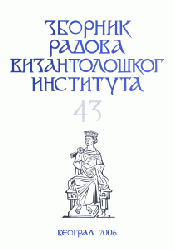Sučeljavanje i prožimanje dvaju svetova
Confrontation and Coalescence of Two Worlds
Author(s): Ljubomir MaksimovićSubject(s): History
Published by: Vizantološki institut SANU
Keywords: Byzantium; Serbia;
Summary/Abstract: The processes characterizing the last century of the existence of Byzantium and Serbia represent both a continuation of the previous historical development and at the same time a negation of this development. The fragmentation of both states, brought about by the growing centrifugal forces, was a new basis for the relationship between Serbia and Byzantium which significantly differed from the preceding situation. The Serbian interest for Byzantium can be identified from the time of Stefan Nemanja. Already at that time, it was an ambivalent relationship: On the one hand, the Serbs were at war with Byzantium, occasionally entering short-term alliances with the Western states; on the other, this was also the time when Serbia made the decisive turn towards the acceptance of the Byzantine Orthodoxy. The importance of Orthodoxy for the general character of Serbia under the rule of the Nemanjic dynasty cannot be overstated, especially since the erection of Hilandar (1198) and the establishment of the Serbian monasticism on the Holy Mountain. The influences coming from Athos to Serbia, like that one of the Hesychast movement, turned the country into a kind of stronghold of Orthodoxy. In spite of its mixed religious composition (Orthodox and Catholic), visible Western influences (trade, mining, armament, partly architecture), and also certain indigenous features (state structure and an important part of the law system), the orthodox aspect of Serbia was one of its decisive features...
Journal: Зборник радова Византолошког института
- Issue Year: 2006
- Issue No: 43
- Page Range: 11-25
- Page Count: 13
- Language: Serbian

